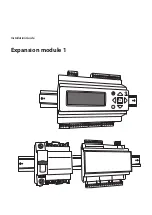
Page 36
LAARS Heating Systems
Gas valve regulation problems can also cause
delayed ignitions. See “Gas valve calibration”.
Incorrect gas orifice – Check orifice size.
A defective burner can cause a delayed ignition
during operation or at shutdown. If the gas supply
pressure is proper the gas valve is functioning
properly and the gas orifice is correct, the burner
should be inspected. To inspect it, remove the blower.
The burner is retained by the blower and it will drop
out of the bottom of the chamber when the blower is
removed. There should be no distortion or perforations
in the burner other than the punched holes. Replace if
indicated.
11.2 Short Cycling
Possible causes
a.
Reduced system flow - EDP
b.
Thermostatic union (EDP) or anti-condensing
valve not opening (EBP).
c.
T-T wires cross connected (jumped) –
improper
installation -
EBP or EDP/EDN
d.
Leakage of flue products into the combustion air
stream – Direct Vent Installations only, see
Section 9.2.3, Resolving Lockouts.
11.3 Noisy Operation
There are two principal sources of noisy
operation:
a.
Combustion - high pitched noise - whistle or
hoot.
b.
Boiling (kettling) - lower frequency noise which
varies with temperature - moan.
Many times it is difficult to determine the source
of the noise or if it is combustion related or boiling
related. Combustion noises always have the same
frequency; however, their volume may change from
the time that the burner first fires to the time that it
shuts off. A boiling noise is identified by rapidly
raising or lowering the system water pressure while
the noise is present. A change in the pitch or intensity
of the noise indicates a boiling problem.
Combustion noise
occurs at any boiler
discharge temperature and is heard the loudest at the
flue outlet (especially on units that are sidewall
vented). There are two basic causes for the noise, rich
mixture (high CO
2
or low O
2
) or cross contamination.
The mixture is determined by measuring the percent
O
2
or CO
2
in the flue products. O
2
readings lower than
4½ % or CO
2
readings higher than 9¼ % (natural gas)
and 10.8% (LP) will often cause combustion related
noise. The rich mixture could be caused by the mis-
calibration of the gas valve (offset adjustment) or by
the gas orifice size. To eliminate the noise; first, check
the gas valve calibration. If it is correct, install a
smaller gas orifice so that the O
2
will rise above 4½%
or the CO
2
will drop to 8½% (natural) or 9½% (LP).
The CO
2
& O
2
readings may be influenced by
cross contamination. Suspect cross contamination if
the noise returns when the front panel is replaced.
Boiling (kettling)
may occur at boiler discharge
temperatures from 170°F to 210°F. The temperature at
which it starts will vary from one installation to
another. The primary cause of the problem is poor heat
transfer on the inside of the boiler coil. This may be
caused by foaming due to excessive concentration of
antifreeze in the system or by scaling from the boiler
water due to hardness of make up water.
Plumbing antifreezes should never be used in a
boiler system. Only boiler antifreezes, with effective
antifoamants, are appropriate for the ENDURANCE
boilers.
NOTE:
The concentration of appropriate antifreeze
should be always be kept as low as possible to
minimize its effect on heat transfer and efficiency.
The method for eliminating the boiling noise is
the same regardless of the cause. However, if
antifreeze in the system is suspected of being the
cause, the concentration (<35%) and type should be
investigated.
Moisture
Although it is not a primary cause of lockouts,
moisture in the combustion chamber may cause
lockouts by weakening the flame signal to the boiler
control. It should be suspected if the boiler
temperature does not rise above 160°F during long
periods of operation. This condition can be caused by
a defective thermostat in the thermostatic union of
EDN or EDP boilers (or the omission of the
thermostatic union at installation) or failure of the
anticondensing valve in the EBP (combi) boilers.
Moisture can also get into the combustion chamber
through an incorrectly pitched or incorrectly installed
flue pipe (pitched back toward the boiler without a
condensate trap). The flue assembly of EBP, EDN and
EDP boilers installed as Direct Vent boilers should
always pitch down from the boiler.
11.4 Insufficient Hot Water (EBP only)
Possible cause:
a.
No flow restrictor (supplied with unit - field
installed)
b.
Water flow switch failure
c.
Mixing valve setting or failure
d.
Domestic hot water (DHW) heat exchanger
contamination
The most common cause for insufficient hot
water complaints results from failure to install a flow
restrictor. The absence of a flow restrictor allows
water to pass through the heat exchanger at a greater
rate than the boiler output is capable of heating to the
desired temperature.





































